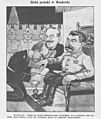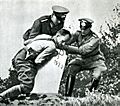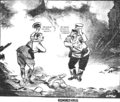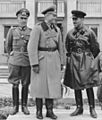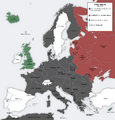Molotov-Ribbentrop pact facts for kids
| German–Soviet Non-aggression Pact | |
|---|---|

Ribbentrop (right) and Molotov (left) at the signing of the Pact
|
|
| Signed | August 23, 1939 |
| Location | Moscow, Russian SFSR, Soviet Union |
| Expiration | August 23, 1949 (planned) June 22, 1941 (effectively) July 30, 1941 (officially declared null and void) |
| Signatories | |
| Languages | German and Russian |
The Molotov–Ribbentrop Pact was a special agreement signed between Nazi Germany and the Soviet Union on August 23, 1939. It is also known as the Nazi-Soviet Pact. This agreement was made by Vyacheslav Molotov, who was the Soviet foreign minister (meaning he handled international relations for Stalin), and Joachim von Ribbentrop, who was the Nazi-German foreign minister (working for Hitler).
The main idea of the pact was that neither country would attack the other. It also secretly planned to divide Poland between them. However, this agreement did not last long. Hitler broke the pact in June 1941 when Germany invaded the Soviet Union. This invasion was called Operation Barbarossa and was a major part of World War II.
Contents
What Was the Molotov–Ribbentrop Pact?
The Molotov–Ribbentrop Pact was a non-aggression treaty. This means it was an agreement where two countries promised not to fight each other. It was signed just before World War II began. The pact was named after the two foreign ministers who signed it: Vyacheslav Molotov from the Soviet Union and Joachim von Ribbentrop from Nazi Germany.
Why Was the Pact Signed?
Both Germany and the Soviet Union had reasons to sign this pact.
- For Germany: Hitler wanted to invade Poland without the Soviet Union getting involved. He also wanted to avoid fighting a war on two fronts at the same time (against countries in Western Europe and the Soviet Union).
- For the Soviet Union: Joseph Stalin wanted to gain time to prepare his country for a possible war with Germany. He also wanted to expand Soviet territory.
Secret Parts of the Agreement
The pact had a secret part, called a "secret protocol." This part divided Eastern Europe into areas of influence for Germany and the Soviet Union.
- Germany would get western Poland and Lithuania.
- The Soviet Union would get eastern Poland, Finland, Estonia, Latvia, and parts of Romania.
This secret agreement showed that both countries planned to take over parts of their neighbors.
How Did the Pact Affect World War II?
The Molotov–Ribbentrop Pact had a big impact on the start of World War II.
- Invasion of Poland: Just one week after the pact was signed, Germany invaded Poland on September 1, 1939. This invasion officially started World War II. The Soviet Union invaded Poland from the east a few weeks later.
- Soviet Expansion: After dividing Poland, the Soviet Union took over the Baltic states (Estonia, Latvia, and Lithuania) and parts of Romania. They also fought a war with Finland, known as the Winter War.
The Pact Is Broken
The agreement between Germany and the Soviet Union did not last.
- Operation Barbarossa: On June 22, 1941, Germany launched a massive surprise attack on the Soviet Union. This was called Operation Barbarossa. Hitler broke the pact because he wanted to conquer Soviet territory and destroy communism.
- New Alliances: When Germany attacked, the Soviet Union joined the Allied powers, fighting against Germany. This changed the course of World War II.
Images for kids
-
Map of the Second Polish Republic, 1937
-
"The Prussian Tribute in Moscow" in the Polish satirical newspaper Mucha of 8 September 1939
-
The New York Times reported Nazi troop movement on 25 August 1939, soon before the Gleiwitz incident on 31 August 1939, led by Alfred Naujocks (pictured).
-
Cartoon in the Evening Standard depicting Hitler greeting Stalin after the invasion of Poland, with the words: "The scum of the earth, I believe?" To which Stalin replies: "The bloody assassin of the workers, I presume?"; 20 September 1939.
-
Common parade of Wehrmacht and Red Army in Brest at the end of the invasion of Poland. At the centre are Major General Heinz Guderian and Brigadier Semyon Krivoshein.
-
Soviet and German soldiers in Lublin
-
"Second Ribbentrop–Molotov Pact" of 28 September 1939. Map of Poland signed by Stalin and Ribbentrop (focused on the Kresy) adjusting the German-Soviet border in the aftermath of German and Soviet invasion of Poland.
-
German and Soviet soldiers meet in jointly-occupied Brest.
-
The new border between Nazi Germany and Soviet Union from September 1939 to June 1941, somewhere in the occupied territory of Poland
See also
 In Spanish: Pacto Ribbentrop-Mólotov para niños
In Spanish: Pacto Ribbentrop-Mólotov para niños




